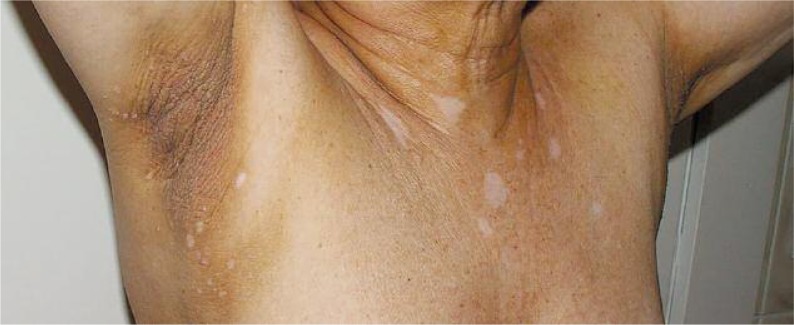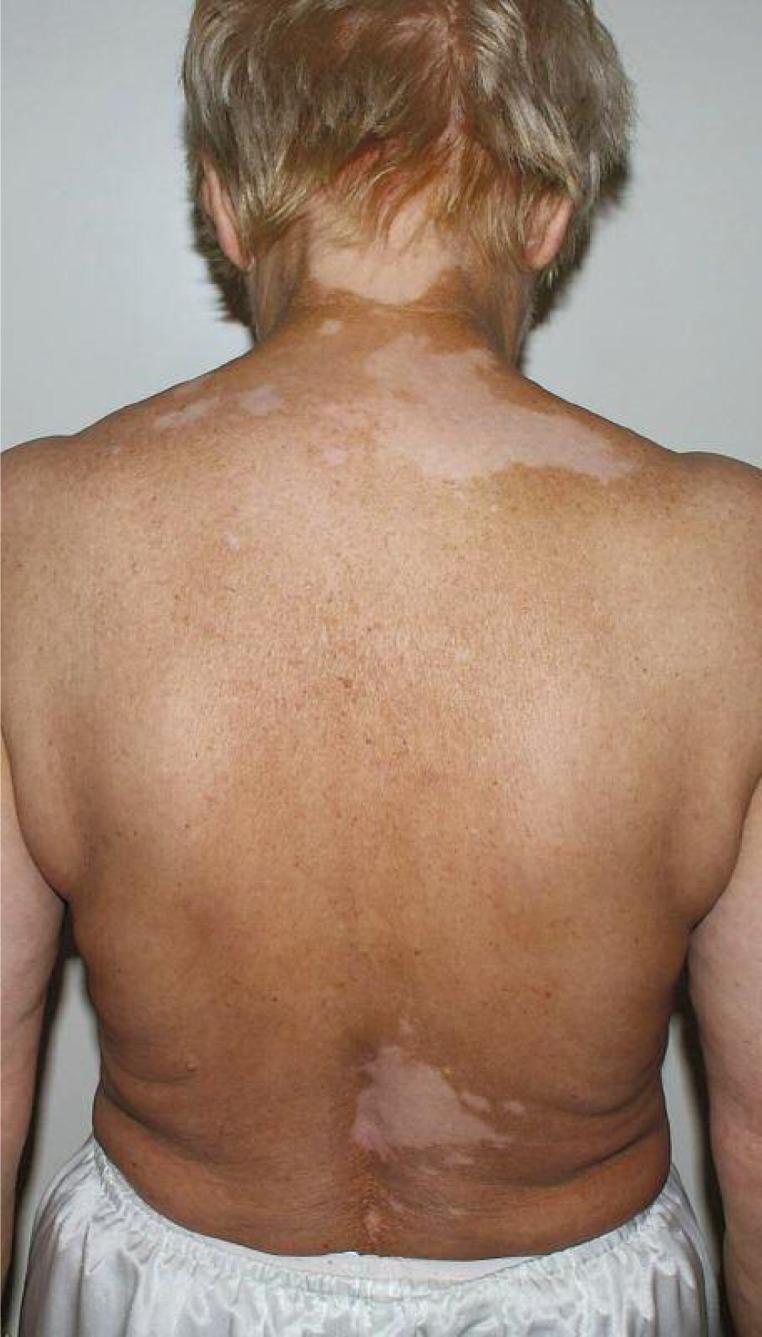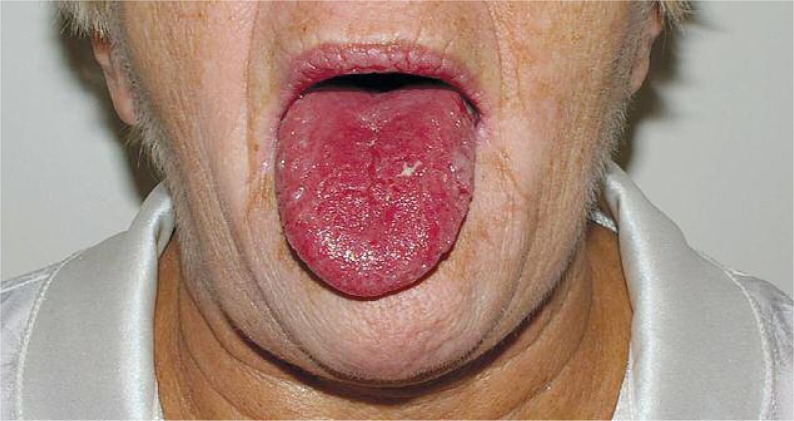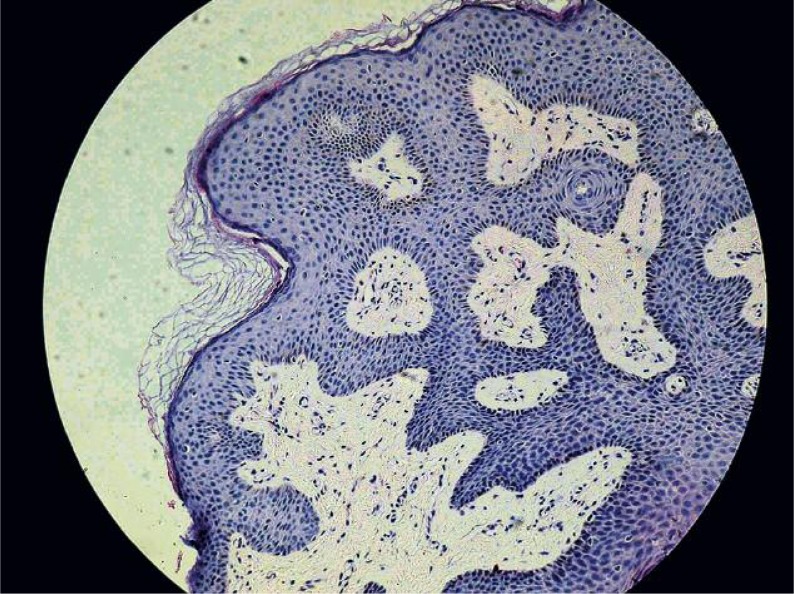Abstract
Acanthosis nigricans (AN) is characterized by the occurrence of symmetrical velvety hyperpigmented plaques that can be observed in each location on the skin. However, the lesions are most frequently located in the axillary, inguinal and nuchal areas. Primarily, the lesions appear as hyperpigmented focuses which later transform into papillary lesions. There are two forms of the disease – benign and malignant. Malignant AN is considered to represent paraneoplastic syndrome co-occurring with advanced cancer, but as such it is not malignant. This article presents a case of a patient diagnosed with AN and coexisting bladder cancer and discusses the case in the context of available literature.
Keywords: acanthosis nigricans, paraneoplastic syndrome
Introduction
Acanthosis nigricans (AN) is characterized by the occurrence of focal hyperkeratosis hyperpigmentation sometimes accompanied by papillary skin hyperplasia. In the majority of cases skin lesions are located in fold areas on the skin. Sometimes the lesions also appear within mucous membrane in the oral cavity. In patients with cachexy AN lesions may be general with accompanying skin itching. The lesions were first described in 1890 by Pollitzer, who observed association of their occurrence with digestive tract cancer [1]. There are two forms of AN: benign and malignant. The benign form, which occurs in children, is congenital, while in adults it may accompany erythema nodosum or some metabolic and hormonal complications, e.g. insulin resistance, obesity, pituitary tumors [2, 3]. On the other hand, the malignant form is associated with the presence of malignant tumors – mainly with gastric adenocarcinoma and then with pancreatic, ovary, lung, esophageal, breast, renal-cell and bladder cancer [4, 5]. The name “acanthosis nigricans” is incorrect from the histopathological point of view because there is no hypertrophy of the spinous layer, and hyperpigmentation is scarce. However, hypertrophy of papilla (church spire pattern) and hyperkeratosis are found. Also melanin deposits are observed in the basal stratum [6].
Most cases are detected at the moment of cancer diagnosis (61.3%). In less than 20% of patients, AN occurs prior to cancer diagnosis, and in 21% AN occurs at a later stage of malignant disease [5].
Differential diagnosis of mucosal lesions must exclude chronic ulcerative inflammation of the oral cavity, where ulceration on the tongue and sometimes on the palate and skin occur. Ulcerative inflammation and mucosal AN are associated with intense pain that hinders talking, eating (especially sweet and salty food), and drinking hot or cold drinks. Other symptoms occurring together with mucosal membrane eruptions may include nervousness, anxiety, apathy and depressive moods [7].
Case description
A 65-year-old female was admitted to the Clinic of Dermatology in July 2010 because of AN lesions to establish diagnosis and initiate treatment. The first lesions appeared in the axillary area in mid-2010. Subsequently, the lesions occurred also on the eyelids, groin and pudendal lips. She underwent cryotherapy and received topical steroids without any clinical benefit. In August 2010, additional lesions associated with burning sensation appeared on the vermilion and tongue. The patient's dentist diagnosed candidosis of the oral cavity and administered ketoconazole for one month.
According to the patient's medical history, she had been previously diagnosed with urinary bladder papilloma. Despite several transurethral resections performed at the Urology Department of Poznan Medical University between December 2010 and March 2011 the tumor was recurring. In March 2011 histopathological analysis of the excised bladder neoplasm revealed bladder adenocarcinoma (low grade). Additionally, the patient had chronic obstructive pulmonary disease and required regular pulmonological consultations. Computed tomography (CT) scans performed in March 2010 revealed no pathology.
Upon dermatological evaluation, numerous grey and brown skin papillary papules with axillary and inguinal areas were revealed. Additionally, hypertrophic lesions coexisting with fissures and numerous cracks were observed at the vermilion and tongue. The patient reported pain in the oral cavity on ingestion of sour or hot food (Figs. 1 and 2). In addition, many vitiligo spots were detected on the back, cleavage, dorsal surface of the hands and on the face (Fig. 3). Due to the suspicion of AN and owing to the risk of coexistence of malignant tumors, particular serum tumor markers such as AFP, CEA, CA125, CA19-9 were analyzed. The test revealed elevation (4× above the upper laboratory limit) of CA19-9 marker. Fecal occult blood test was negative. Due to the presence of lesions in the oral cavity, culture of the area was taken and physiological pharyngeal flora was found. Ultrasound examination of the abdominal cavity revealed enlarged retroperitoneal and abdominal lymph nodes – the greatest ones in the liver hilus (30 mm in diameter). The patient initiated regular lavage of the oral cavity with disinfectant agents and nystatin. A skin specimen collected from the right axillary was evaluated by the pathologist: skin covered with acanthotic epidermis and hypertrophic skin papilla – suspicion of acanthosis nigricans (Fig. 4).
Fig. 1.

Numerous gray and brown papules in the axillary area
Fig. 2.
Lesions on mucous membranes in the course of acanthosis nigricans
Fig. 3.

Vitiligo lesions on the neck and back
Fig. 4.
Histologic examination reveals hyperkeratosis, papillomatosis with minimal or no acanthosis or hyperpigmentation.
The dermal papillae project upward as fingerlike projections and correlate with the clinical picture (H+E staining, magnification 40×)
Following diagnosis of AN and in order to perform detailed diagnosis of lymphadenopathy the patient was admitted to a local comprehensive cancer center. She underwent CT scanning of the abdominal cavity which demonstrated enlarged retroperitoneal lymph nodes along the aorta and iliac vessels. The lymph nodes in the retroperitoneal space both in the abdominal cavity and in the pelvis minor were unambiguously suspected of the malignant process. All of them contained a necrotic component, which weighted against lymphoma and suggested metastatic lymph nodes. The patient was consulted in the Surgical Outpatient Clinic of the Greater Poland Cancer Center in Poznan, and at that moment neoplastic hyperplasia in the abdominal cavity was excluded despite elevated levels of Ca19.9 tumor marker.
Discussion
Acanthosis nigricans is characterized by the occurrence of symmetrical velvety hyperpigmented plaques that can be present anywhere on the skin. However, the lesions are most frequently located within axillary, inguinal and nuchal areas. Primarily the lesions appear as hyperpigmented focuses which later transform into papillary lesions. Dark color of the lesions may result from greater melanin production or increased proliferation of melanocytes [8]. Local or generalized skin itching occurs especially in the case of AN in the course of neoplastic processes. Lesions in the oral cavity are more frequent in the case of malignant AN [8]. Oral form of AN is characterized by extensive papillary lesions on lips, palate, gums and tongue. The lesions may spread over the nose, throat or esophagus.
Presumably AN is induced by factors stimulating proliferation of epidermal keratinocytes and skin fibroblasts. In benign forms of AN, the main role is played by epidermal growth factors. On the other hand, malignant AN is stimulated by tumor- and host-secreted growth factors such as transforming growth factor α (TGF-α) [8, 9].
Acanthosis nigricans is a disease entity occurring in the course of a cancer; however, a few reports also demonstrate an association between AN and other generalized diseases or particular congenital syndromes [10]. Benign AN form may occur in patients at every age and may be associated with congenital diseases or particular drugs [8]. The most common diseases associated with benign or malignant ANs are presented in Tables 1 and 2.
Table 1.
Diseases and drugs associated with benign form of acanthosis nigricans [10]
| Endocrinological diseases |
| Acromegaly |
| Addison's disease |
| Cushing's syndrome |
| Diabetes type 2 |
| Insulin resistance syndrome (types A,B,C) |
| Obesity |
| Polycystic ovary syndrome |
| Congenital syndromes |
| Ataxia telangiectasia |
| Bloom syndrome |
| Prader-Willi syndrome |
| Total lipodystrophy |
| Drugs |
| Estrogens |
| Glucocorticosteroids |
| Fusidic acid |
| Nicotinic acid |
Table 2.
Diseases associated with malignant acanthosis nigricans [10]
| Squamous cell carcinoma |
| Lungs, cervix, subglottis |
| Adenocarcinoma |
| Esophagus, large intestine, hepatic ducts, pancreas, ovaries, urinary bladder, lungs, testicles, mammary gland |
| Lymphoma |
| Hodgkin's and non-Hodgkin's disease |
| Others |
| Mycosis fungoides, osteosarcoma |
Malignant AN has been considered as a paraneoplastic syndrome co-occurring with cancers, but as such it is not malignant [8]. This form is less frequent than benign AN and is more often observed in middle-aged or old individuals [11]. A sudden occurrence of AN lesions in the area of anatomical fossae, on elbows, knees, in the intermammary area or around the anus in patients over 40 years of age should act as a warning signal for a physician setting a requirement of thorough medical examination in order to exclude a neoplastic process. Earlier research demonstrated that malignant form of AN may precede the occurrence of cancer in 17–20% of cases [12]. Most malignant cancers co-occurring with AN originate from organs located in the abdomen. In the case of the described patient, a neoplastic lesion was located in the urinary bladder. Analysis of the collected material gave a histopathological image of bladder adenocarcinoma, which is a rare cancer originating from within the bladder wall. Despite topical and systemic antifungal treatment, the patient continued to present with hypertrophic lesions with distinct excessive fissures in the oral cavity. Mucosal lesions associated with AN should be distinguished from other disease entities of the oral cavity mucous membrane. Very similar lesions located on the tongue can be observed in the course of e.g. Miescher-Melkersson-Rosenthal syndrome (MMR). They present as fissures (lingua plicata) and occur in about 20–40% of patients with the syndrome. Other symptoms of the MMR syndrome are granulomatous cheilitis and facial nerve paralysis [13]. In the differential diagnosis of AN one also has to exclude Addison's disease, arsenic poisoning and hemochromatosis. As opposed to AN, these lesions are never accompanied by papilla. Other diseases that should be taken into consideration in the differential diagnosis are: ichthyosis hystrix, pemphigus vegetans, Hailey-Hailey disease, bromoderma, hairy tongue, and condyloma acuminata [14–16].
Since the bladder tumor had microscopic adenocarcinoma features, one cannot exclude that the elevated level of Ca19-9 marker corresponded to advanced bladder carcinoma. CT-guided biopsy of enlarged lymph nodes did not provide confirmation of dissemination of bladder cancer and laparoscopic excision of pathological lymph nodes is planned.
The persistence of AN symptoms despite treatment seems to confirm the presence of an advanced malignant process probably originating in the bladder. However, due to the extensive medical history of the patient, a further medical screening is required in order to exclude the presence of other primary malignant lesions located especially within the digestive tract.
Regardless of the underlying cause, the proper treatment of AN symptoms has not been finally established. In rare cases, treatment of the basic disease, i.e. neoplastic disease, results in regression of skin lesions. The treatment of AN symptoms may include retinoids or PUVA therapy (psoralens + photochemotherapy). Despite little effect of symptomatic treatment, patients suffering from AN lesions located within the oral cavity always require therapy in order to prevent malnutrition and subsequent cachexia.
The authors declare no conflict of interest.
References
- 1.Pollitzer S. Acanthosis nigricans. In: Unna PG, Morris M, Besnier E, editors. International atlas of rare skin disease. London: HK Lewis & Company; 1890. pp. 1–3. [Google Scholar]
- 2.Stolinsky DC. Paraneoplastic syndromes. West J Med. 1980;132:189–208. [PMC free article] [PubMed] [Google Scholar]
- 3.Nair PS, Moorthy PK, Suprakasan S, Jayapalan S, Sarin M. Malignant acanthosis nigricans with liver secondaries from an occult primary adenocarcinoma of gastrointerstinal tract. Indian J Dermatol Venereol Leprol. 2005;71:197–8. doi: 10.4103/0378-6323.16239. [DOI] [PubMed] [Google Scholar]
- 4.Kleikamp S, Böhm M, Frosch P, Brinkmeier T. Acanthosis nigricans, papillomatosis mucosae and “tripe palms” in a patient with metastasized gastric carcinoma. Dtsch Med Wochenschr. 2006;131:1209–13. doi: 10.1055/s-2006-941753. [DOI] [PubMed] [Google Scholar]
- 5.Pentenero M, Carrozzo M, Pagano M, Gandolfo S. Oral acanthosis nigricans, tripe palms and sign of leser-trélat in a patient with gastric adenocarcinoma. Int J Dermatol. 2004;43:530–2. doi: 10.1111/j.1365-4632.2004.02159.x. [DOI] [PubMed] [Google Scholar]
- 6.Burgdorf WHC, Plewig G, Wolff HH. Dermatologia Braun-Falco. T. 3. Lublin: Czelej; 2011. pp. 1367–9. [Google Scholar]
- 7.Szymanek M, Krasowska D. Chronic ulcerative stomatitis – pathogenesis, clinical manifestations and therapy. Post Dermatol Alergol. 2009;26:518–21. [Google Scholar]
- 8.Schwartz RA. Acanthosis nigricans. J Am Acad Dermatol. 1994;31:1–19. doi: 10.1016/s0190-9622(94)70128-8. [DOI] [PubMed] [Google Scholar]
- 9.Hermanns-Lę T, Hermanns JF, Piérard GE. Juvenile acanthosis nigricans and insulin resistence. Pediatr Dermatol. 2002;19:12–4. doi: 10.1046/j.1525-1470.2002.00013.x. [DOI] [PubMed] [Google Scholar]
- 10.Rogers DL. Acanthosis nigricans. Semin Dermatol. 1991;10:160–3. [PubMed] [Google Scholar]
- 11.Kierland RR. Acanthosis nigricans: an analysis of data in twenty-two cases and a study of frequency in necropsy material. J Invest Dermatol. 1947;9:299–305. doi: 10.1038/jid.1947.102. [DOI] [PubMed] [Google Scholar]
- 12.Curth HO. Classification of acanthosis nigricans. Int J Dermatol. 1976;15:592–3. doi: 10.1111/j.1365-4362.1976.tb04895.x. [DOI] [PubMed] [Google Scholar]
- 13.Rosińska-Więckowicz A, Misterska M, Bartoszak L, et al. Cheilitis – case study and literature review. Post Dermatol Alergol. 2011;3:231–9. [Google Scholar]
- 14.Sedano Ho, Gorlin RJ. Acanthosis nigricans. Oral Surg Oral Med Oral Pathol Oral Radiol Endod. 1987;63:462–7. doi: 10.1016/0030-4220(87)90259-3. [DOI] [PubMed] [Google Scholar]
- 15.Karlińska M, Waszczykowska E, Torecka JD. Trudności diagnostyczne dotyczące pęcherzycy bujającej – opis przypadku. Post Dermatol Alergol. 2010;5:440–4. [Google Scholar]
- 16.Lis-Święty A, Brzezińska-Wcisło L, Bergler-Czop B. Hailey-Hailey disease and contact hipresensitivity. Post Dermatol Alergol. 2011;3:224–7. [Google Scholar]




